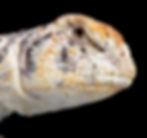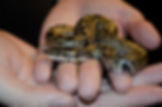
Blue-Tongued Skink Care Guide
Blue-Tongued Skink Care Tips: Everything You Need To Know About Your Pet Blue-Tongued Skink
Captive blue-tongued skinks typically live between 15 and 20 years when cared for properly, though some individuals have exceeded the expected lifespan by as much as a decade. They are relatively large lizards who can grow to 50-60cm and require a minimum enclosure size of 2’x2’x4’ as adults.
Caretakers should be aware that these animals require a significant commitment of both time and space when considering these wonderful reptiles as a pet. Moreover, blue-tongued skinks should have the benefit of a specialized exotic pet vet rather than a traditional veterinarian.

The Natural History of Blue-Tongued Skinks
Blue-tongued skinks (Tiliqua spp.) are a family of stocky, short-legged lizards native to Australia, Tasmania, Papua New Guinea and Indonesia and best known for their vivid blue tongues. The species of Tiliqua most commonly kept in captivity are the Indonesian blue-tongued skink (Tiliqua gigas), the Australian blue-tongued skink (Tiliqua scincoides) and the shingleback skink (Tiliqua rugosa), whose natural habitats vary greatly; from woodland, forest margins and semi-arid deserts. These lizards are diurnal omnivores who spend the majority of their days foraging for plants, invertebrates, insects, carrion and small animals on the forest floor. Owners should know their companion’s species, natural habitat and natural behaviors in order to provide their skink with high-quality care.


How to Care for Your Pet Blue-Tongued Skink
Enclosure
Adult blue-tongued skinks are terrestrial and should be provided with a minimum of 8sq feet of horizontal space to explore, though larger enclosures are strongly recommended. Vertical space is less important for these terrestrial lizards with a minimum depth of 2ft. Juvenile skinks thrive in smaller enclosures while larger environments tend to cause stress, therefore it will be necessary for caretakers to upgrade the size of the skink’s enclosure as they grow. All enclosures housing skinks should be well ventilated and include a sturdy mesh lid capable of supporting various heating and lighting elements secured with lid locks, as skinks are excellent escape artists when given the opportunity.
Structural Enrichment
Blue-tongued skinks require multiple secure hide boxes large enough for the skink to crawl under, placed on both the warm and cool sides of the enclosure. Pet owners can choose from a number of different materials for hides such as sterilized mopani wood, cork, plastic, PVC piping, slate and ceramic, though found materials (rocks, branches, used flower pots, etc.) should never be used as they may introduce parasites, toxins or other harmful materials into the enclosure.
Branches, well-secured rocks and other low, easily accessible structures may be placed in the enclosure to allow for exploration and climbing.
Skinks should always have access to at least one heavy water dish large enough for them to soak in and shallow enough to allow for easy access in and out of the water.
Substrate
As with other reptiles, we do not recommend loose or shredded organic or mineral substrates due to their tendency to harbor parasites, foster bacteria, increase humidity to undesired levels, irritate the mucous membranes, increase the risk of respiratory disease and risk of fatal impaction. The best substrates for your skink would be Repti-carpet, flat paper towels, or brown paper. Common substrates that can be hazardous and should be avoided are fir bark, cypress mulch, pine or cedar shavings, clay cat litter, calci-sand, untreated potting soil and walnut shells. Because skinks are naturally inclined to burrow we recommend safely enabling this important natural behavior.
How to Keep Your Skink Tank Clean
The cleanliness and overall condition of your lizard's enclosure has a significant impact on your pet’s health.
When it comes to hygiene, be sure your substrate is cleaned daily as well as the water and food dishes. Cleaning and changing the placement of tank furnishings regularly not only provides a clean enclosure but can help keep your skink interested and engaged in their environment.
Providing the Right Climate for Your Blue-Tongued Skink
Blue-tongued skinks thrive in moderate ambient temperatures between 75-85°F with a basking spot at 90-95°F. Maintaining a temperature gradient (mid-70s on the cool end and mid-80s at the warm end) is important as it allows the skink to regulate her own temperature. At night, the coolest side of the enclosure may be allowed to fall as low as 70°F.
These temperatures should be monitored with thermometers on each end of the enclosure and maintained using ceramic heat emitters and/or other heat-producing bulbs. Blue-tongued skinks require full-spectrum UVA and UVB lighting for 12 hrs each day, and bulbs should be replaced every 6 months. Never use "hot rocks" or "heat caves," and avoid under-tank heaters and heat tape as skinks may suffer from severe burns if they come too close to these heating sources. Instead, keep heating bulbs out of reach, or about 8-12 inches above the enclosure.
Blue tongued skinks are classified as “mid-day baskers” and, along with other sun-loving species such as bearded dragons and monitor lizards, require a relatively strong UVB output in captivity, which can be achieved by using 80-100W bulbs, such as ZooMed.
Different species of blue-tongued skink enjoy different humidity levels (between 25% to 45%) that should be measured with a hygrometer. Adding a localized spot of high humidity with something like wet paper towels or damp sphagnum moss will help your skink, especially when shedding.
Skink Diet and Nutrition
What Do Blue-Tongued Skinks Eat?
As omnivores, blue-tongued skinks eat a little bit of everything. Your lizard should be provided about 60% plant food (50% greens/vegetables and 10% fruit) and 40% animal protein.
-
Vegetable options: dark leafy greens (collards, dandelion, mustard, escarole, etc.), green beans, peas, squash, carrots, parsnips, zucchini, bell peppers, parsley, hibiscus flowers
-
Fruit options: berries, pitted cherries, peaches, nectarines, pears, banana, melons, mango, papaya
-
Animal protein options: gut-loaded insects (earthworms, crickets, roaches, snails, mealworms, occasional waxworms, etc.), rodents (pinkie and fuzzy mice) and occasionally hard-boiled eggs.
Whole ground-prey diets can also be purchased to increase variety. Young blue-tongued skinks should be fed once daily, while adults should be fed every 2-3 days.
Recommended Treats and Supplements
In order to guarantee that your blue-tongued skink is getting all the nutrition and vitamins it needs, dust its food with a reptile multivitamin once to two times per month, and dust a calcium carbonate supplement without D3 once per week, and with Vitamin D3 at every feeding.
Blue-Tongued Skink Behavior
Of all skink species, blue-tongued skinks are the most popular pets because of their fascinating color and interactive personalities. The lizards are generally friendly and certain individuals even seek out contact with humans. If you want to make physical interaction a regular activity with your blue-tongued buddy, try handling it several times per week. Doing so will help your pet get used to you and slowly increase their enjoyment at being held. Always pick up your lizard slowly from the side where it can see you. Sudden moves or grabbing him from above could increase rather than decrease its fear of you.

Medical Care for Blue-Tongued Skinks
Of course, maintaining your skink’s health should be your top priority so it can live out a full and happy life in your care.
Here are some common disorders you should look out for as a blue-tongued skink owner:
-
Nutritional secondary hyperparathyroidism ("metabolic bone disease")
-
Respiratory infections
-
Abnormal or incomplete shedding
-
Fungal skin infections
-
Thermal burns from improper heat sources
-
Bite wounds from other skinks if not housed individually or from prey items
-
Parasites (internal or external)
-
Stomatitis or "mouth rot"
-
Obesity
Many commonly seen conditions are the result of malnutrition and/or inadequate housing and are preventable.
Make sure to avoid:
-
Close contact with heat sources
-
Unsecured housing
-
Contact with dogs or cats
-
Soiled substrate and water
-
Allowing the enclosure to get too hot or too cold
Boarding for Blue-Tongued Skinks
If you suspect that your blue-tongued skink is suffering from any health issues or have any questions about providing your skink with a healthy living environment, the Long Island Bird and Exotics Veterinary Clinic is a trusted source of information and care. We also offer boarding for Blue-Tongued Skinks in the wake of any necessary medical procedures or if you are planning an extended trip away from home.
Whatever the case, you can rest or travel easily knowing that your blue-tongued skink is in the best of hands with LIBEVC.












